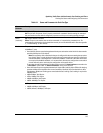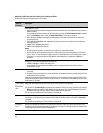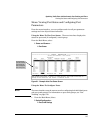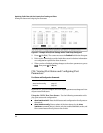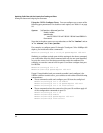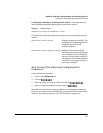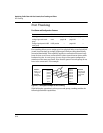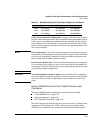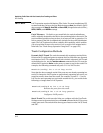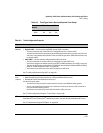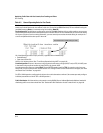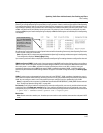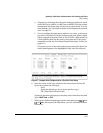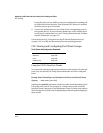
Optimizing Traffic Flow with Port Controls, Port Trunking, and Filters
Port Trunking
Table 9-2. Bandwidth Capacity for Trunk Groups Configured for Full-Duplex
10 Mbps Links 100 Mbps Links 1000 Mbps Links
2 Ports Up to 40 Mbps Up to 400 Mbps Up to 4000 Mbps
3 Ports Up to 60 Mbps Up to 600 Mbps Up to 6000 Mbps
4 Ports Up to 80 Mbps Up to 800 Mbps Up to 8000 Mbps
Port Connections and Configuration: All port trunk links must be point-
to-point connections between the Series 5300XL Switches and another switch,
router, server, or workstation configured for port trunking. No intervening,
non-trunking devices are allowed. It is important to note that ports on both
ends of a port trunk group must have the same mode (speed and duplex) and
flow control settings.
Not e Link Connections. The switch does not support port trunking through an
intermediate, non-trunking device such as a hub, or using more than one media
type in a port trunk group. Similarly, all links in the same trunk group must
have the same speed, duplex, and flow control.
Port Security Restriction. Port security does not operate on a trunk group.
If you configure port security on one or more ports that are later added to a
trunk group, the switch will reset the port security parameters for those ports
to the factory-default configuration.
Caution To avoid broadcast storms or loops in your network while configuring a
trunk, first disable or disconnect all ports you want to add to or remove from
the trunk. After you finish configuring the trunk, enable or re-connect the
ports.
Series 5300XL Switches Port Trunk Features and
Operation
The Series 5300XL Switches offers these options for port trunking:
LACP (IEEE 802.3ad—page 9-25)
Trunk (non-protocol—page 9-30)
FEC (Fast EtherChannel®—page 9-30)
The switch supports 36 trunk groups of up to four ports each. (Using the Link
Aggregation Control Protocol—LACP—option, you can include standby
trunked ports in addition to the maximum of four actively trunking ports.)
9-11



